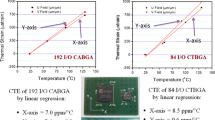Fatigue crack growth tests of lead-containing (Sn-37Pb) and lead-free (Sn-3.0Ag-0.5Cu) solders were conducted at frequencies ranging from 0.1 Hz to 10 Hz at stress ratio of 0.1, at room temperature and at 70°C. The J-integral range (ΔJ) and the modified J-integral (C *) were used in assessing the cycle-dependent and time-dependent crack growth behavior for both solders. The experimental results showed that the crack growth behavior of both solders at the lower frequency and higher temperature was predominantly time dependent, whereas the crack growth behavior of both solders at the higher frequency and lower temperature was predominantly cycle dependent, with the transition in fatigue crack growth behavior from cycle dependent to time dependent expressed as f + 6500exp(1/T) = 6520. In both the cycle-dependent and time-dependent regions, the crack growth resistance of the lead-free solder was higher than that of lead-containing solder. Fracture surface observations showed that, as the frequency decreased and/or the temperature increased, the fracture path changed from transgranular to intergranular for Sn-37Pb solder, and from transgranular to mixed transgranular–intergranular for Sn-3.0Ag-0.5Cu solder.
Similar content being viewed by others
References
Y. Kariya, T. Morihata, E. Hazawa, and M. Otsuka, J. Electron. Mater. 30, 1184 (2001).
Y. Kariya and T. Suga, Fatigue Fract. Eng. Mater. Struct. 30, 413 (2007).
R.S. Sidhu, X. Deng, and N. Chawla, Metall. Mater. Trans. A A39, 349 (2008).
J. Yu, D.K. Joo, and S.W. Shin, Acta Mater. 50, 4315 (2002).
Y. Ding, C. Wang, M. Li, and H.S. Bang, Mater. Sci. Eng. A A384, 314 (2004).
H.D. Solomon, Life Prediction and Accelerated Testing.The Mechanics of Solder Alloy Interconnects, ed. D.R. Fear, S.N. Burchett, H.S. Morgen, and J.H. Lau (New York: Van Nostrand Reinhold, 1994), p. 199.
D.J. Xie, Y.C. Chan, J.K.L. Lai, and I.K. Hui, IEEE Trans. Compon. Packag. Manuf. Technol. B19, 669 (1996).
J. Zhao, Y. Miyashita, and Y. Mutoh, Int. J. Fatigue 23, 723 (2001).
J. Zhao, Y. Mutoh, Y. Miyashita, and L. Wang, Eng. Fract. Mech. 70, 2187 (2003).
C. Kanchanomai and Y. Mutoh, Int. J. Mech. Mater. Eng. 2, 1318 (2008).
K. Tanaka, Eng. Fract. Mech. 77, 1750 (2010).
T.W. Woo, M. Sakane, K.S. Kim, K. Kobayashi, and H.C. Park, Int. J. Mech. Mater. Eng. 4, 1410 (2010).
N. Hidaka, H. Watanabe, and M. Yoshiba, J. Electron. Mater. 38, 670 (2009).
JSMS Committee on High Temperature Strength of Materials, Low Cycle Fatigue Standard for Solder Testing (Japan: The Society of Materials Science, 2000).
N.E. Dowling, Crack and Fracture, ASTM STP 601 (1976), p. 19.
T. Yafuso, M. Itokazu, T.A.P. Kacou, S. Kubo, and K. Ohji, J. Mech. Mater. Eng. 38, 97 (1995).
M. Yoda, M. Nabetani, and H. Okabe, Eng. Fract. Mech. 70, 2235 (2003).
Author information
Authors and Affiliations
Corresponding author
Rights and permissions
About this article
Cite this article
Fakpan, K., Otsuka, Y., Mutoh, Y. et al. Creep–Fatigue Crack Growth Behavior of Pb-Containing and Pb-Free Solders at Room and Elevated Temperatures. J. Electron. Mater. 41, 2463–2469 (2012). https://doi.org/10.1007/s11664-012-2061-2
Received:
Accepted:
Published:
Issue Date:
DOI: https://doi.org/10.1007/s11664-012-2061-2




